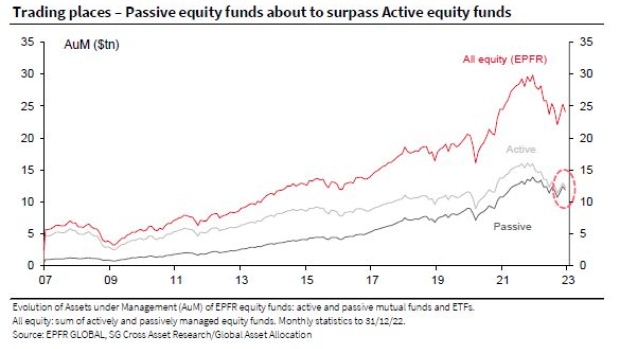Feb 21, 2023
Global Passive Equity Funds Set to Overtake Active Funds
, Bloomberg News

(Bloomberg) -- Passively managed equity funds are on the cusp of marking a milestone that’s been more than a decade in the making: Globally, net assets in such products are about to exceed those of their actively managed counterparts, according to Societe Generale.
The “fund industry is about to pass a symbolic milestone,” potentially in March or April, based on monthly data from EPFR Global, wrote a SocGen team led by Arthur Van Slooten.
“Obviously, this is mainly a symbolic hurdle, but we can be reassured by the fact that US equity funds passed it in a convincing way mid-2021, apparently without any major hiccups,” they wrote.
Passive strategies have been gaining market share for years thanks to characteristics like lower management fees. In the US, passive investing has risen steadily. At least 19% of the shares of the average publicly listed US stock is owned by passive mutual funds or passive ETFs, tripling since 2013, according to an analysis by James Seyffart at Bloomberg Intelligence. Adding other structures would raise that toward 30%, he said.
ETFs and mutual funds own some $16 trillion of the roughly $44 trillion of publicly held US equities, with the rest in the hands of individuals, corporations, insurance companies, pensions and other entities, according to BI.
Money managers including Michael Burry, Bill Ackman and Cathie Wood have decried the trend, though BI says it’s largely attributed to investors choosing lower-cost products.
Meanwhile, in the credit market, passive funds are also attracting cumulative net inflows, whereas active ones are seeing outflows, according to SocGen.
To be sure, “bond and credit funds may need considerably longer before the size of active and passive funds converges,” they wrote.
The active-passive overtake “is clearly an omen that only high value-added is likely to be rewarded,” the SocGen strategists said. “For most investors, it mainly implies a shift in how they approach investment: from stock-picking to fund-picking.”
--With assistance from Sam Potter.
(Adds details on ownership, size of publicly held market.)
©2023 Bloomberg L.P.






